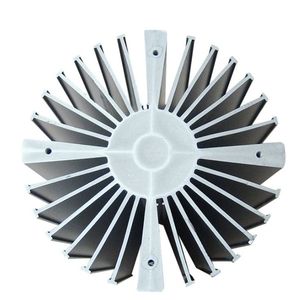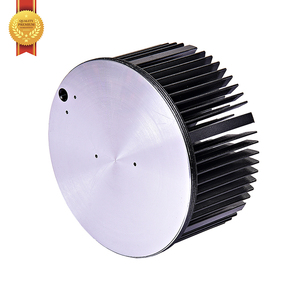(820 products available)










































































































































































There are several types of heatsink 40mm products. Here is a detailed overview of the most common types:
40mm Aluminum Heatsink
This product is made of aluminum, which is lightweight and has good thermal conductivity. It comes in different designs, such as extruded, folded, and finned. An extruded aluminum heatsink is made through the extrusion process, which creates heatsinks with different shapes and sizes. Finned and folded aluminum heatsinks have patterns and folds, which increase the surface area for heat dissipation. These patterns and folds are added during the machining process.
40mm Copper Heatsink
Copper is a metal known for its excellent thermal conductivity. The copper heatsink is usually made through the machining process. This product is more effective at transferring heat from the source to the dissipating area. However, copper is heavier than aluminum.
Combined Aluminum and Copper Heatsink
This product combines the advantages of both aluminum and copper. It usually features copper at the base for efficient heat transfer and aluminum fins for lightweight and enhanced dissipation. The aluminum and copper are combined through extrusion or by using a copper insert.
Active Heatsink
This is a type of 40mm heatsink with a fan attached to it. The fan helps circulate air and increase the cooling efficiency of the heatsink. These products are commonly used in applications where there is a high amount of heat that needs to be dissipated. The active heatsink cools down electronic components more effectively than passive heatsinks.
Passive Heatsink
This product does not have a fan attached to it. It relies on natural convection to cool down the electronic components. Air circulates around the heatsink, dissipating the heat. Passive heatsinks are popular in low-power applications since they are lightweight and quiet.
The 40mm heatsink has a wide range of applications and features. Here are some of them.
Function
The primary function of a 40mm heatsink is to dissipate heat from electronic components. This is usually through conduction and convection. Electronic components like GPUs, CPUs, and power transistors generate heat during operation. Excess heat can lead to component failure. A good 40mm heatsink helps to spread and transfer this heat to the surrounding air. This is thus preventing overheating and ensuring optimal performance.
Features
The 40mm Heatsink has several features that make it an ideal choice for cooling electronic components. These features include:
Aluminum or Copper Construction
Aluminum or copper construction makes the 40mm heatsink lightweight and cost-effective. Aluminum heatsinks are easy to manufacture and are very affordable. On the other hand, copper has a higher thermal conductivity. Some designs use a combination of both aluminum and copper to maximize the benefits of both materials.
Compact Size
The 40mm size is small and compact. As a result, it is suitable for use in applications where space is limited. This includes embedded systems, laptops, and small form-factor PCs. Its compact size enables it to cool electronic components without occupying a lot of valuable board space or system space.
High Cooling Efficiency
The 40mm heatsink is optimized for high cooling efficiency. This is by maximizing surface area and airflow. It has fins or a ribbed structure that increases surface area for heat dissipation. Higher surface area allows for more heat to be transferred to the air, thus lowering the temperature of the electronic component.
Compatibility with 40mm Fans
The 40mm heatsink is usually designed to work together with a 40mm cooling fan. The fan enhances airflow over the heatsink surface. This is thus further increasing heat dissipation. A combination of passive and active cooling solutions provides efficient thermal management for high-performance applications. The heatsink reduces the speed at which the fan operates. This minimizes power consumption and noise.
Easy Mounting
The 40mm heatsink is usually designed for easy mounting on PCBs or electronic components. It has mounting holes or brackets that facilitate simple and secure installation. Some heatsinks come with adhesive thermal pads or paste for straightforward assembly and disassembly. This reduces the need for screws or other hardware.
Customization
The 40mm heatsink is customizable to meet specific requirements. This is for different applications or optimize performance for different electronic components. Customization options include different materials, shapes, sizes, and mounting solutions.
40mm heatsinks are used in various applications, especially where compact designs are essential, and efficient cooling of electronic components is required. Here are some common use cases:
CPU Cooling
Heatsinks are often used in cooling central processing units (CPUs) in computers and other electronic devices. A 40mm heatsink with fan can be mounted on a CPU to dissipate heat during operation and keep it stable.
Graphic Processing Units (GPUs)
GPUs used in gaming consoles, computers, and other devices also require cooling. A 40mm GPU heatsink can be used to cool the graphics card and prevent overheating.
Power Electronics
Power transistors, MOSFETs, and IGBTs are commonly used in industrial equipment, electric vehicles, and renewable energy systems. A 40mm heats sink can dissipate heat generated by these components to ensure they operate efficiently.
LED Lighting
High-power LED lights produce heat that must be dissipated to ensure longevity and efficiency. Designers of LED lighting systems can integrate 40mm heatsinks into their designs to provide adequate cooling.
Embedded Systems
Compact electronic devices such as Raspberry Pi, Arduino, and other embedded systems use 40mm heatsinks. These devices are used in IoT applications, small form factor PCs, and other projects where space is limited.
Networking Equipment
Routers, switches, and modems can use 40mm heatsinks to cool their processors and other components. This is especially common in high-performance networking equipment used in data centers and telecom facilities.
Consumer Electronics
CD/DVD/Blu-ray drives, home theater receivers, and other electronic devices use 40mm heatsinks in their internal components. This is to ensure that they operate efficiently and deliver optimum performance.
Industrial Machinery
Machinery such as motors, drives, and controllers can be fitted with 40mm heatsinks. This is especially applicable in precision cooling applications where reliable operation is critical.
Telecommunications Equipment
40mm heatsinks are used in devices such as amplifiers, modulators, and routers. This is to ensure that they operate efficiently and maintain signal integrity.
Custom Electronic Designs
Engineers and designers can incorporate 40mm heatsinks into their custom electronic designs. This is to solve specific cooling challenges or constraints in a given application.
When choosing a 40mm heatsink, there are several factors that customers must consider to ensure that the product will meet the requirements of their intended application. Here are some of them:
Consider the Type of Heatsink
Heatsinks are classified into two; passive and active. The passive 40 mm heatsink does not have a fan. It relies on natural convection to cool down the component. The heatsink is ideal for applications that need low power or are very small. The active 40 mm heatsink has a fan. It uses forced convection to cool down the component. The heatsink provides better cooling capabilities. It is ideal for high-power applications.
Cooling Requirements
The cooling requirements include the maximum allowable temperature and the power dissipation of the component. Customers can determine the maximum allowable temperature and the cooling power needed. They can then choose a 40 mm heatsink that meets their requirements. The heatsink should not allow the component temperature to exceed the maximum allowable temperature.
Material and Durability
40 mm heatsinks are made of aluminum or copper. Aluminum heatsinks are lightweight and cost-effective. They are also good at dissipating heat. Copper heatsinks have a high thermal conductivity. They are more effective at dissipating heat but are heavier than aluminum. Business owners should choose a material that meets their application needs. They should also consider the material durability. For instance, the material should be able to withstand extreme temperatures and environmental conditions.
Compatibility
The 40 mm heatsink must be compatible with the electronic component it is cooling. Buyers should consider the size and the mounting options of the heatsink. They should also consider the thermal interface material (TIM). The TIM is used between the heatsink and the component to enhance thermal transfer.
Space Constraints
Business owners should consider the available space in their electronic device. If the space is limited, they should choose a compact heatsink. They can also consider other designs like the heatsink with fins or the heat pipes.
Q1: What is the purpose of a 40mm heatsink?
A1: A 40mm heatsink's primary purpose is to dissipate heat away from electronic components, such as CPUs or GPUs. By spreading this heat into the air, the 40mm heatsink helps keep these crucial parts at safe operating temperatures. This, in turn, enhances their performance and prolongs their lifespan.
Q2: How is a heatsink installed?
A2: A heatsink can be installed in several ways, depending on the type being used. Some heatsinks are mounted directly onto the component using thermal paste, while others may have clips or screws for secure attachment. There are also heatsinks that come with adhesive backing for easy installation.
Q3: How can one determine if a heatsink is working properly?
A3: One can know if a heatsink is working properly by checking the temperature of the component it is cooling. If the temperature is within the recommended range, it means the heatsink is working properly. If it is not, then one may need to replace the heatsink or check if it is properly installed.
Q4: Can a heatsink be used without a fan?
A4: Yes, a heatsink can be used without a fan. However, it will not be as effective in cooling the electronic component as it would be if a fan was attached. In some cases, though, a heatsink can be used without a fan, especially if the component does not produce a lot of heat.
The keyword "heatsink 40mm" has experienced a noticeable fluctuation in web search volumes over the past year. The average monthly web search volume stands at 50, with a significant three-month and one-year change of -29%. Over the last 12 months, the web search volumes have shown varied peaks and valleys, with the highest web searches recorded in December 2023 and August 2024 at 70, and the lowest in February 2024 at 30.
Analyzing the detailed trend of "heatsink 40mm," it's evident that the web search volume peaks during specific months, notably December and August. This suggests a seasonal influence, possibly linked to consumer behavior during colder months when the need for efficient cooling solutions in electronics might decrease, leading to dips in web search volumes like those observed in February. The gradual rise in web searches from June to August could be attributed to the onset of warmer weather, prompting consumers to seek better cooling solutions for their electronics.
The consistent -29% change over both the three-month and one-year periods indicates a sustained downward trend in interest or demand for heatsink 40mm products. This could reflect broader market dynamics or shifts in consumer electronics trends, where newer or more efficient cooling technologies might be emerging, thereby affecting the web search volumes for this specific product.